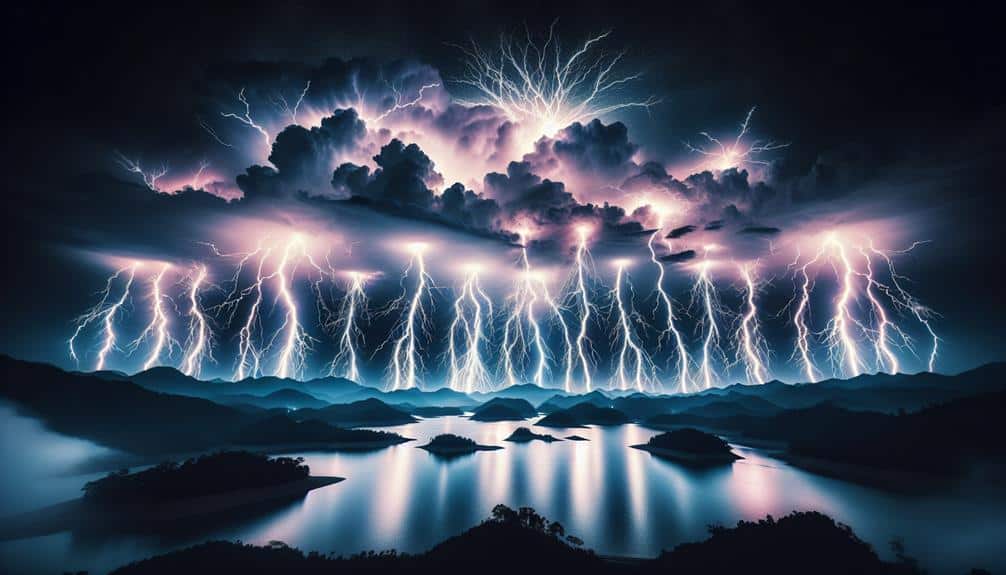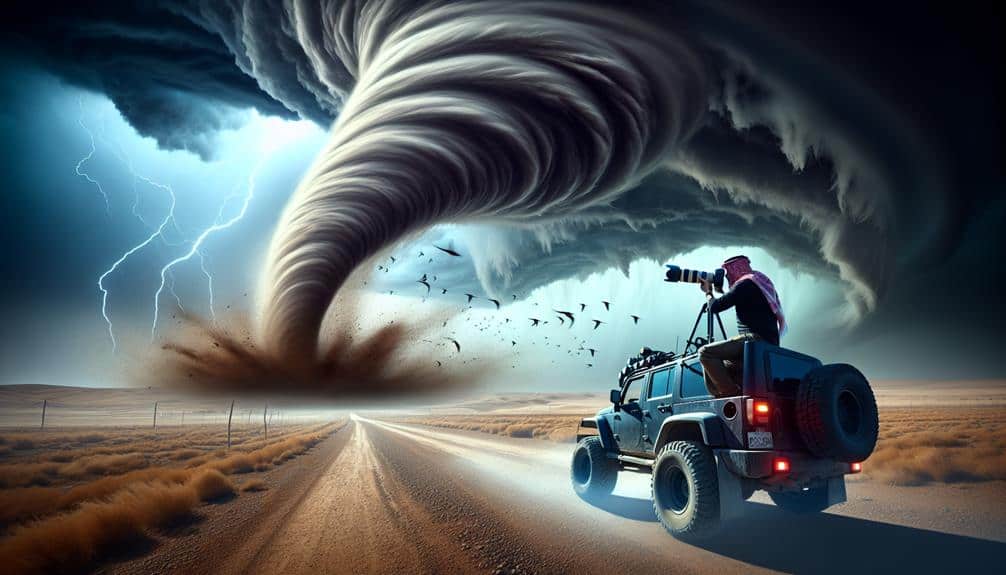We can achieve stunning documentation of severe weather aftermath through three key photographic techniques. First, wide-angle shots capture the scene's scale and context, using lenses from 10-24mm and natural light for striking results. Second, focusing on details with macro lenses reveals textures and patterns, adding artistic depth and emotional resonance. Finally, utilizing drones provides unparalleled aerial perspectives, showcasing the true scope of the damage with high-resolution images and automated flight paths. Each method offers a unique viewpoint, enabling us to tell a thorough story of the storm's impact. To master these techniques, let's explore further.
Key Points
- Use drones for aerial shots to capture the extensive scope of the damage.
- Take wide-angle shots to provide context and show the scale of destruction.
- Focus on detailed close-ups to highlight specific damage and tell compelling stories.
- Utilize natural lighting, especially during golden hours, for warm and balanced images.
Capture Wide-Angle Shots
To effectively document the scale and context of severe weather aftermath, we should prioritize capturing wide-angle shots that encompass the full extent of the scene. By doing so, we accurately convey the magnitude and impact of the event. Wide-angle lenses, typically ranging from 10-24mm, enable us to include more elements within the frame, thereby providing a detailed view.
Lighting techniques play a critical role in enhancing these wide-angle shots. Natural light during the golden hours—just after sunrise or before sunset—casts soft, warm tones that add depth and dimension to our images. In contrast, overcast conditions provide diffuse lighting, reducing harsh shadows and creating a more even exposure. Utilizing these lighting conditions strategically can greatly elevate the visual impact of our photographs.
Composition tips are equally essential. We should apply the rule of thirds, placing key elements along the gridlines to create balanced and engaging images. Leading lines such as roads, fallen trees, or damaged structures can guide the viewer's eye through the scene, adding a sense of direction and narrative.
Focus on Details
While wide-angle shots provide an overarching view, focusing on specific details captures the intricate aftermath elements that tell a compelling story. By directing our lenses towards close up shots, we can reveal textures, patterns, and nuances that might otherwise go unnoticed.
The twisted metal of a collapsed structure, the delicate droplets on a battered leaf, or the fractured lines of a shattered window all contribute to a vivid narrative of the storm's impact.
We should aim for unique perspectives to enhance our documentation. Instead of a straightforward shot of debris, let's get low to the ground or angle our cameras upward to convey the magnitude and chaos. This approach not only adds artistic depth but also ensures our photos resonate emotionally with viewers.
Precision is key. Use macro lenses to capture minute details with clarity. Pay attention to lighting; early morning or late afternoon light can add dramatic shadows and highlights. Employ a shallow depth of field to isolate subjects, directing attention to significant elements within the frame.
Utilize Drones
Harnessing the capabilities of drones, we can capture aerial perspectives that reveal the true scale and scope of severe weather aftermath with unparalleled clarity. By deploying drones, we access a vantage point that's otherwise unattainable, providing us with unique angles and a detailed overview of the post-storm damage.
Drones serve as essential surveying tools, allowing us to meticulously document expansive areas quickly and safely. With high-resolution cameras and advanced stabilization technology, drones enable us to produce sharp, detailed images that are vital for accurately evaluating the extent of the damage. This aerial perspective isn't only visually compelling but also invaluable for creating precise damage reports and facilitating relief efforts.
Moreover, drones afford us the flexibility to maneuver through challenging terrains and capture footage from multiple elevations and viewpoints. This adaptability ensures that we can document both broad landscapes and specific, hard-to-reach areas with equal effectiveness. The ability to program flight paths and automate image capture further enhances our efficiency, reducing the time and effort required for thorough documentation.
In leveraging drone technology, we can push the boundaries of traditional photography, turning our artistic vision into a powerful tool for understanding and responding to severe weather events.
Frequently Asked Questions
What Camera Settings Work Best for Photographing Severe Weather Aftermath?
Remember how a painter captures chaos with precision? That's our goal. We use wide focal lengths and small aperture settings for depth. Ideal lighting conditions and strong composition techniques are crucial for impactful severe weather aftermath photography.
How Can I Safely Photograph in Hazardous Post-Storm Conditions?
We must prioritize safety precautions by wearing protective gear and using durable equipment. In hazardous conditions, employ stable photography techniques such as using tripods and remote triggers to capture powerful images without risking our safety.
Are There Specific Times of Day That Provide Better Lighting for Documenting Damage?
During golden hour, the sun's low angle casts soft, warm light that highlights details, unlike harsh midday shadows. We've found at sunset, the light beautifully captures the drama of severe weather aftermath, enhancing both clarity and mood.
What Equipment Should I Bring for Photographing Severe Weather Aftermath?
We should bring lighting equipment to guarantee proper exposure, especially in low-light conditions. Protective gear is essential to keep us safe from debris and hazards. High-quality cameras, tripods, and wide-angle lenses will enhance our photographic documentation.
How Can I Ethically Photograph Affected Individuals and Properties?
How do we ethically photograph affected individuals and properties? By prioritizing ethical considerations and respectful portrayal, addressing privacy concerns, and undergoing sensitivity training. Let's capture their resilience with dignity, ensuring our artistic vision respects their freedom and humanity.


